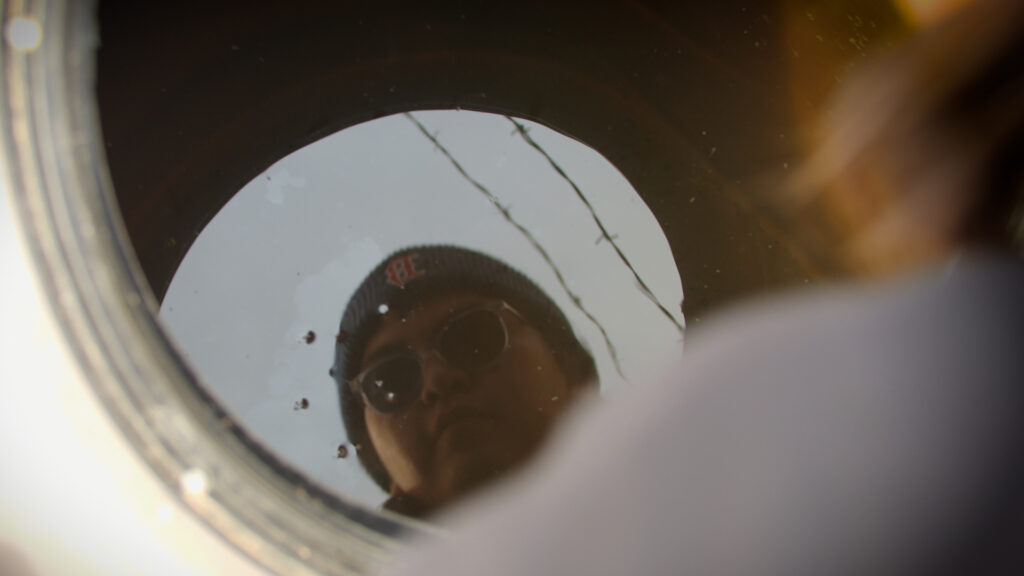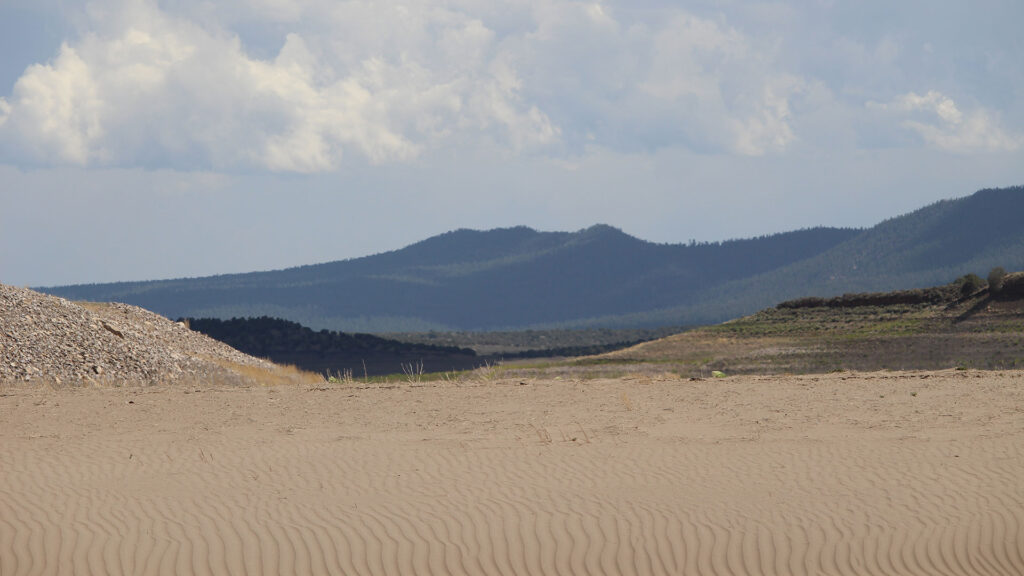Too much news to summarize in a subject line…

If you missed our documentary, “Ancestral Connections,” last Thursday, you can watch it on our website or on YouTube. Or, you can download the PBS app on your Smart TV and watch on-demand, just like with Netflix or Amazon.
A big thanks to Megan Kamerick at KUNM and Richard Eeds at KSFR for having me on their shows to talk about the project and all that we learned along the way. And if you don’t already, you should follow the Pueblo of Santa Ana’s Department of Natural Resources on Facebook so you can see more about their work (and watch a ton of wildlife videos).
On Friday, a BNSF train hauling gasoline and propane derailed near the Arizona-New Mexico border, spurring evacuations and closing traffic on a fifty-mile stretch of Interstate 40.
According to the Associated Press, nearby homes were evacuated; the news agency also reported: “The train was transporting non-odorous propane and gasoline, and a half-dozen rail cars caught fire and burned for hours after the derailment, New Mexico State Police Lt. Phil Vargas said.”
At first, there was confusion over whether the derailment occurred in New Mexico or Arizona. And although commercial television stations reported on the accident and the highway closures over the weekend, a lot of questions remain. This morning, KOB-TV reported that train traffic is moving again, but it’s unclear how long it will take BNSF to remove the derailed cars. The story also quotes an attorney who says there are about 40 property owners in the area.
I’ve reached out to various agencies, including the New Mexico Department of Transportation, the National Transportation Safety Board (which is observing the investigation), and the Federal Railroad Administration (which is leading the investigation and whose officials have been on the scene since Friday).
I’ll keep you posted on the investigation and anything else I learn. But, boy, don’t you all wish that there were still thriving local newspapers across rural areas of New Mexico and the United States? Nothing like being able to read on-the-ground reporting from people who know their own communities and can hold companies and officials accountable while also informing residents of any dangers.
As an aside, the Our Land crew was filming at the Pueblo of Acoma a few weeks ago, and we were shocked to watch the train traffic that people in the lower villages endure throughout the day and night. That I-40 railway corridor is so busy — and even busier now that there are seemingly endless waves of Amazon containers.
Meanwhile, students at Thoreau High School, about 30 miles east of Gallup along I-40, recently sent letters to politicians and media outlets, opposing a plan to relocate uranium mining waste into Thoreau.
It’s a complicated issue, that bears delving into some history.
In the 1970s and ‘80s, Kerr-McGee and the Quivira Mining Company extracted five million pounds of uranium ore from three mines on the Navajo Nation, then left radioactive waste behind in the Red Water Pond Road Community. When the mines closed in 1983, the buildings were demolished and removed, sediment from the contaminated ponds was excavated and dumped into mine shafts, and waste piles were covered with one foot of soil.
According to the New Mexico Environmental Law Center, which has represented the Red Water Pond Road Community Association for ten years, in 2007 the U.S. Environmental Protection Agency removed six inches of radioactive dirt from residents’ yards, but residents “still deal with radioactive air emissions and water pollution.”
In 2019, NMELC filed with the Human Rights Committee on behalf of the association, charging that the United States has violated the International Covenant on Civil and Political Rights. According to that report, “The United States’ historic and current practice in remediating radioactive and toxic waste in minority communities generally, and indigenous communities specifically, reveals a pattern of disparate impacts on minority and indigenous communities resulting in abrogation of the rights to life, family, exercise of culture, and freedom from discrimination.”
Now, according to a 2023 story from Hannah Grover, the U.S. Environmental Protection Agency is “considering two alternatives for the waste: capping it and storing it at the site in the Red Water Pond Road Community or hauling it off for disposal at a nearby landfill in the Thoreau area.”
That landfill could include waste not only from the defunct Quivira Mine but also “waste left behind by hundreds of uranium operations across the Navajo Nation.”
KOAT-TV’s Andres Valle visited the Thoreau High School students and sought comment from Gov. Michelle Lujan Grisham, who noted the state hasn’t received permit applications yet — and added “that they needed to send their concerns to the companies involved in the planning of the uranium waste site to participate in the conversations to stop it.”
Thoreau, or Dlǫ́ʼí Yázhí, is a small town, and about 80 percent of its residents are Navajo; in their letter opposing the storage of mine waste in Thoreau, students wrote, “We view this proposal as reminiscent of colonialism.”
“We implore you to listen to us!” students wrote. “We are tired of being overlooked and taken advantage of, and if our voices remain unheard, nothing will ever change.”
Indeed, while the U.S. government has failed for more than fifty years to protect the residents of Red Water Pond Road Community, moving the waste into Thoreau hardly seems like a just plan.
Meanwhile, the private corporations and shareholders who profited from the mines moved on to other projects and new ventures long ago.
Because I’ve been focused on “Ancestral Connections” and another project (which I can’t wait to tell you about), I haven’t had time to cover water issues in the state.
Thankfully, John Fleck still takes to his blog regularly, including on Monday to note that spring runoff on the Rio Grande may have already peaked.
Fleck has also posted twice about El Vado Dam on the Rio Chama, a tributary of the Rio Grande. El Vado Reservoir has been empty the past couple of years as the U.S. Bureau of Reclamation and its contractors have been rebuilding the 1930s-era dam.
Now, as Fleck first noted on April 10, Reclamation is “halting work” on the dam’s repairs. This will have big — and long-term — implications, he writes, for farmers, the City of Albuquerque, the endangered silvery minnow, and the Middle Rio Grande’s flows in summer.
In a follow-up post, Fleck quoted Norm Gaume, who points out that because New Mexico currently owes a 122,000-acre-foot debt to Texas under the Rio Grande Compact, New Mexico can’t store water in El Vado Reservoir anyway.
As Fleck noted: “Norm is making an incredibly important point here. El Vado is important in the long run. In the short run, thanks to the Rio Grande Compact’s rules, we wouldn’t be able to use it anyway this year to store spring runoff to stretch out irrigation through the summer. Unless and until we get our Compact debt under control, it doesn’t matter whether, when, or how we fix El Vado.”

A look at some of the other news:
• “Taos County ditches debate Chevron dollars” (Geoffrey Plant, Taos News)
• “While FEMA money trickles in, local groups promote post-fire recovery in Mora” (Alice Fordham, KUNM)
• “New Mexico gets massive $156M boost for solar equity” (Bryce Dix, KUNM)
• “$500 million for solar energy for tribal families” (Joaqlin Estus, Source NM)
• “New EPA rules will force fossil fuel power plants to cut pollution” (Robert Zullo, Source NM)
• “New Mexico gets massive $156M boost for solar equity” (Bryce Dix, KUNM)
• “US military bases teem with PFAS. There’s still no firm plan to clean them up.” (Sachi Kitajima Mulkey, Grist, Source NM)
• “Environmentalists prepare to defend new BLM rule against legal challenges” (Alice Fordham, KUNM)
• “Renewable energy companies need more workers for a green transition” (Megan Gleason, Albuquerque Journal)
• “2024 Arizona wildfire season: Winter rains fuel summer fire risk” (Kira Caspers, Arizona Republic)
• “New Study: Climate Change Could Reduce the World Economy 19% By 2049” (Jon McGowan, Forbes)
• “‘Snow deluge’ years on the decline across the US West, thanks to climate change: Study” (Sharon Udasin, The Hill)
• “Climate change is fueling a rise in heartworms among dogs, cats in the Pacific Northwest” (April Ehrlich, Oregon Public Broadcasting)
• “The ‘Epic Row’ Over a New Epoch” (Elizabeth Kolbert, The New Yorker)
There’s also a guest essay in The New York Times from Benji Backer, “I’m a Young Conservative, and I Want My Party to Lead the Fight Against Climate Change.”
Lastly, since it came out last fall, y’all might have already read “Eight Bears” by Gloria Dickie. But I’ve really been enjoying it and learning a lot. You can track it down at your local library and read reviews in places like The Guardian and Science News.
P.S. If a friend forwarded you this message, sign up here to receive the newsletter yourself. You can also read recent newsletters online. And if you miss us throughout the week, follow Our Land on Instagram.


